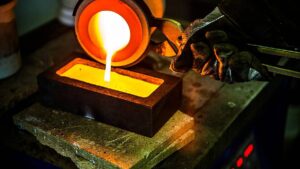It’s time to stop comparing the Pilbara to South Africa’s Witwatersrand, say experts

Pic: Bloomberg Creative / Bloomberg Creative Photos via Getty Images
Since gold nuggets were discovered in the West Pilbara last year, it’s been fashionable to compare the region to South Africa’s gold-rich Witwatersrand Basin.
The Witwatersrand Basin, or the Wits for short, is a geological formation that houses the world’s biggest known gold reserves, producing about half the world’s gold.
But a West Australian government mining authority has poured cold water on the idea.
There is some evidence that South Africa’s Kaapvaal Craton and the Pilbara Craton were once part of the same continent — possibly even joined. But the only similarities appear to be that they both host gold in sedimentary “conglomerate” rock.
“I just see different geodynamic histories, tectonic settings and depositional settings,” said Dr Ian Tyler, assistant director at the Geological Survey of Western Australia (part of the State government’s mining department).
“The Kaapvaal is sediment-hosted. It’s volcanic-dominated in the Pilbara. There’s no Dominion Group in the Pilbara. There’s no Gorge Creek Basin or Whim Creek Basin in the Kaapvaal.
“The Mallina Basin and West Rand Group may be time equivalents — but there doesn’t seem to be a Central Rand Group in the Pilbara and therefore no Main Reefs.
“Which is a bit sad — but I am open for people to prove it wrong.”
Dr Tyler was speaking at Informa’s Pilbara Conglomerate Gold Conference in Perth on Wednesday.
> Think the Pilbara gold story is over? Here’s 100m reasons you’re wrong
West Wits Mining (ASX:WWI), which is now mining from its landholding in the Wits and recently picked up ground in the Pilbara, backs that view.
“In the bigger picture, we see some similarities between the Pilbara and the Witwatersrand. Both are gold in conglomerates, but that’s really where the similarities end at this stage,” exploration director Andrew Tunks told Stockhead.
“The gold in the Witwatersrand is not nuggetty.”
Because of the nuggetty nature of the gold in the Pilbara, it has proven difficult to drill.
Canada’s Novo Resources – which was responsible for the initial find mid-last year – has determined bulk sampling is the way to go.
But Mr Tunks says the “jury is still out” on how big the Pilbara gold rush could eventually be.
> Bookmark this link for small cap breaking news
> Discuss small cap news in our Facebook group
> Follow us on Facebook or Twitter
> Subscribe to our daily newsletter
“Clearly there is a lot of gold up there, but there’s some really big questions about how it might be developed,” he said.
“I’m sure they’ve got a lot of smart people working on it and so will we, once we get up there. But it’s very early days for us.”
West Wits has started small-scale mining in South Africa. Its goal is to become a 100,000-ounce producer from a massive landholding in the Central Rand, which alone has produced 275 million ounces.
“While we have projects in both [the Pilbara and the Wits], for us the main game — while we are waiting for people to understand the Pilbara — is very much concentrating on revitalising our Wits project,” Mr Tunks said.
UNLOCK INSIGHTS
Discover the untold stories of emerging ASX stocks.
Daily news and expert analysis, it's free to subscribe.
By proceeding, you confirm you understand that we handle personal information in accordance with our Privacy Policy.








